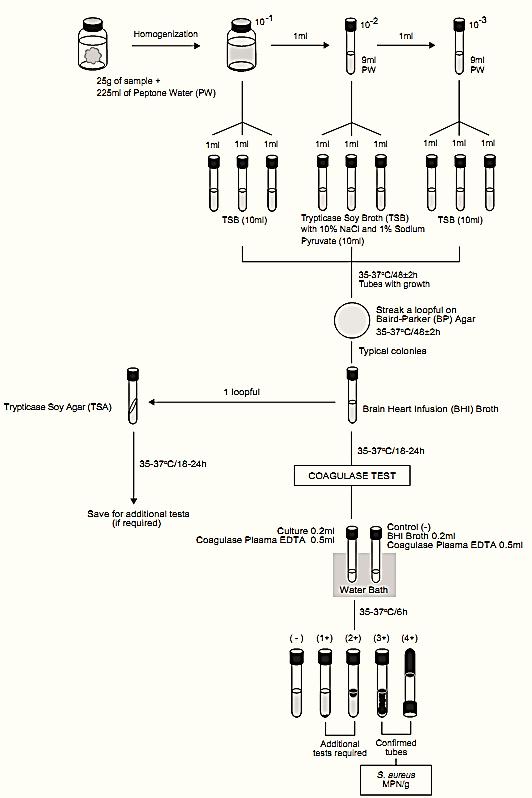


 النبات
النبات
 الحيوان
الحيوان
 الأحياء المجهرية
الأحياء المجهرية
 علم الأمراض
علم الأمراض
 التقانة الإحيائية
التقانة الإحيائية
 التقنية الحيوية المكروبية
التقنية الحيوية المكروبية
 التقنية الحياتية النانوية
التقنية الحياتية النانوية
 علم الأجنة
علم الأجنة
 الأحياء الجزيئي
الأحياء الجزيئي
 علم وظائف الأعضاء
علم وظائف الأعضاء
 الغدد
الغدد
 المضادات الحيوية
المضادات الحيوية| Most probable number (MPN) method for coagulase positive staphylococci and S. aureus in foods |
|
|
|
Read More
Date: 15-3-2016
Date: 14-3-2016
Date: 2025-02-16
|
Most probable number (MPN) method for coagulase positive staphylococci and S. aureus in foods
Method of the American Public Health Association (APHA), as described in the 4th Edition of the Compendium of Methods for the Microbiological Examination of Foods (Lancette & Bennett, 2001).
This method is recommended for products in which small numbers of S. aureus and a large population of competing species are expected.
1 - Material required for analysis
Preparation of the sample and serial dilutions
• Diluent: 0.1% Peptone Water (PW) or Butterfield’s Phosphate Buffer
• Dilution tubes containing 9 ml of 0.1% Peptone Water (PW) or Butterfield’s Phosphate Buffer
MPN Counting
• Trypticase Soy Broth (TSB) with 10% NaCl and 1% Sodium Pyruvate (10 ml tubes)
• Baird Parker (BP) Agar plates
• Laboratory incubator set to 35–37°C Confirmation
2 - Procedure
A general flowchart for the enumeration of coagulase positive staphylococci and Staphylococus aureus in foods using the Most Probable Number (MPN) method APHA 2001 is shown in Figure 1.
a) Preparation of the samples and inoculation.
preparation serial dilutions of sample (10−1, 10−2 and 10−3). Inoculate three 1 ml portions of each dilution into three tubes containing 10 ml of Trypticase Soy Broth (TSB) with 10% NaCl and 1% Sodium Pyruvate. Incubate tubes at 35–37°C/48 ± 2 h and examine for visible growth.
b) Confirmation. Streak a loopful from each tube showing growth (turbidity) on the surface of Baird-Parker (BP) Agar plates. Incubate the plates at 35–37°C/48 ± 2 h and examine for typical S. aureus colonies, From each plate showing growth, select at least one suspect colony and confirm. In the absence of suspected colonies, consider the tube negative for S. aureus.
c) Calculation of results. Record the number of con-firmed tubes and determine the MPN/g or MPN/ ml, using one of the MPN tables.

Figure 1 Scheme of analysis for the enumeration of coagulase positive staphylococci and Staphylococus aureus in foods using the Most Probable Number (MPN) method APHA 2001 (Lancette & Bennett, 2001).
References
Silva, N.D .; Taniwaki, M.H. ; Junqueira, V.C.A.; Silveira, N.F.A. , Nasdcimento , M.D.D. and Gomes ,R.A.R .(2013) . Microbiological examination methods of food and water a laboratory Manual. Institute of Food Technology – ITAL, Campinas, SP, Brazil .
Lancette, G.A. & Bennett, R.W. (2001) Staphylococcus aureus and staphylococcal enterotoxins. In: Downes, F.P. & Ito, K. (eds). Compendium of Methods for the Microbiological Examination of Foods. 4th edition. Washington, American Public Health Associa-tion. Chapter 39, pp. 387–403.



|
|
|
|
للعاملين في الليل.. حيلة صحية تجنبكم خطر هذا النوع من العمل
|
|
|
|
|
|
|
"ناسا" تحتفي برائد الفضاء السوفياتي يوري غاغارين
|
|
|
|
|
|
|
بمناسبة مرور 40 يومًا على رحيله الهيأة العليا لإحياء التراث تعقد ندوة ثقافية لاستذكار العلامة المحقق السيد محمد رضا الجلالي
|
|
|